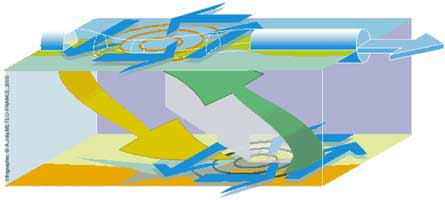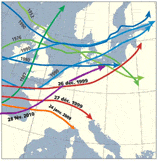The storms are generated by horizontal thermic contrasts in the air and may grow stronger on earth unlike cyclones. Storms occur especially during the fall and winter months. But they can in spring and summer even if it is rare. When the oceans are still so warm and the polar air already cold, the gradient of temperature between the two air masses involved is important. The higher the gradient is the greater the power of the storm will be. Some storms may be the remains of an Atlantic tropical cyclone in later life that has retained sufficient energy and taken by western currents which bring them to Europe. On their way, the weather conditions they will encounter can sometimes provide them sufficient energy to be qualified of storms.
Birth and evolution of a storm Then, when the warm front disappears precipitations drain the last drops, the storm subsided and the stationary front is reformed, waiting for the next cycle. Some storms absorb their energy in the reservoir of thermal potential energy of the jet stream as it was the case for the storms of 1999, 2010... in France.
As this diagram shows us a vortex
exists at the surface another in altitude Storms occur mostly when the N.A.O. index (North Atlantic Oscillation) is positive as the pressures of the Azores are high and low in Iceland what affects the speed of the wind, sea temperature, heat flux, height of waves, storm track, and profiles of evaporation and precipitation. They mainly depend on the position of the jet stream hardly predictable.
WARNING |




